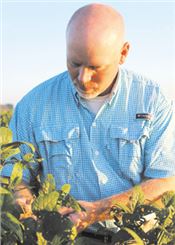|
Moisture Sensors Help End Soybean Irrigation

Soil moisture sensors let producers know when crops need irrigation. Jason Krutz,
Mississippi State University Extension Service irrigation specialist, examines the
development stage of these soybeans Sept. 7, 2016, at the
Delta Research and Extension Center in Stoneville.
Photo by MSU DREC Communications/Kenner Patton
STARKVILLE, MISS.
Dry September weather has Mississippi soybean producers on opposite ends of the irrigation spectrum: Some are done, while others want to water one more time.
Jason Krutz, irrigation specialist with the Mississippi State University Extension Service, has a question for them: What do the soil moisture sensors say?
“Soil moisture sensors allow us to know exactly when the crop needs water,” Krutz said. “Some producers cut off the water too soon, and some cut it off too late. The only way to know how to get it just right is to have soil moisture sensors.”
Krutz said a recent Soybean Promotion Board survey found 20 percent of Mississippi soybean producers use soil moisture sensors. That number is far above the national average of 1.5 percent, but Krutz will not be satisfied until all Mississippi farmers are using these tools to irrigate efficiently.
“I’m pushing a lot of guys to tell them, we’re not done with the crop yet. Keep irrigating,” Krutz said. “I’m working with other producers who are eager to irrigate, and they want to send water down the field one more time.”
Although much of Mississippi’s soybean crop has reached the maturity stage of R6.5 and needs no further moisture, many acres are not there yet. Krutz said at this maturity stage, pod walls start to turn from deep green to light green, and the beans inside have reached full size.
“When soybeans are at maturity stage R6, if we don’t get a rain or they don’t irrigate, they will have yield loss,” Krutz said.
Trent Irby, Extension soybean specialist, said irrigation termination decisions are based on the soybean growth stage and the availability of water in the soil.
“Using soil moisture sensors, we have a good idea of how much moisture is available in the soil profile. It’s important to base these decisions off of both soil moisture availability and the crop’s stage of development,” Irby said. “We want to make sure the crop has what it needs until it’s finished, and these sensors are great tools to help us do so.”
Mississippi soybeans are typically irrigated four to five times a year. Timely rains early in the season lowered that number on many soybean acres. Krutz said three tools help producers irrigate at the right time and in the most efficient manner to save money while maintaining high yields.
“In furrow-irrigation situations, if you get the delivery right with a pipe planner to select the right size water hole and use surge irrigation, then the soil moisture sensors will allow you to irrigate at the right time,” he said.
After the crop has reached maturity at the R6.5 stage, producers leave it in the field to dry down. Producers like to harvest when the crop has about a 13 percent moisture content. At this level, grain can be safely harvested and stored. ∆
|
|